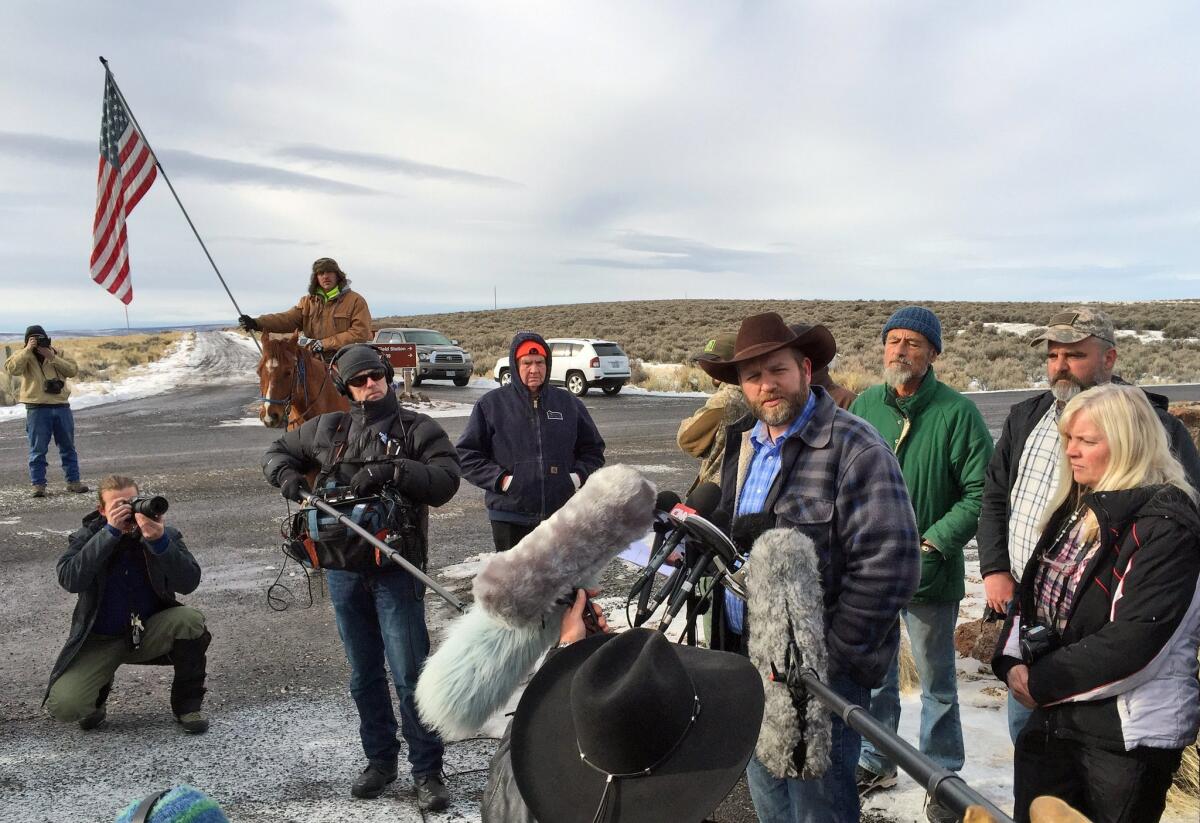Op-Ed: Before the Bundy gang, I ‘occupied’ Malheur National Wildlife Refuge

Ammon Bundy speaks to reporters at the Malheur National Wildlife Refuge in Burns, Ore. on Jan. 14. Bundy is the leader of a small, armed group that has been occupying the remote refuge since Jan. 2 to protest federal land policies.
- Share via
The ongoing “occupation” of the Malheur National Wildlife Refuge headquarters in Harney County, Ore., has brought to mind my dark past as an “occupier” of that same facility.
It was late fall of 1978, and I was a student at the University of Oregon Law School. Fed up with contracts and torts, I decided I needed some fresh air and time off. Where could I go for a week on my shoestring budget?
A gladly transplanted New Jerseyan, I’d already seen the forests and mountains of western Oregon. When I asked for advice, some friends told me that I really should check out the southeastern corner of the state — that it was God’s country out there. The guidebook promised high desert mountain ranges, big skies, cattle ranches the size of my home state, scenic hot springs and friendly people.
I had no car and no money, so I set out by thumb from Eugene for Burns, about 250 miles east, the biggest town in the area. I got there pretty easily. My plan was to explore a big loop, past the Malheur National Wildlife Refuge, down to the small settlements of Fields and French Glen, around the imposing face of Steens Mountain, and then back along the Alvord Desert, with a stop for a soak at Alvord Hot Springs.
But first I had to get out of town and find a free place to spend the night. I was used to the wet, warm weather west of the Cascades and had underestimated how much colder it would be on the high desert. My Army-surplus sleeping bag was no match for eastern Oregon temperatures.
Just as night was falling, a friendly rancher picked me up and dropped me off at the Malheur National Wildlife Refuge. I thanked him and walked over to the small collection of buildings, hoping to get out of the weather.
There wasn’t a soul around. I saw a small building labeled “Museum” and tried the door. To my delight, it was unlocked. I walked in, turned on the lights and found myself amid an extraordinary collection of everything to do with birds: stuffed birds, pictures of birds, bird nests, bird eggs. More to the point, I had found a sheltered area out of the weather where I could bed down for the night and have some assurance of waking up alive.
I spent a pleasant night with the birds. In the morning, I rolled up my sleeping bag, turned out the lights and shut the still-unlocked door. In the morning light, the refuge was magnificent. I’d never seen so many birds, and this time they were all alive. There were thousands of them, crowding the shallow waters of Malheur Lake, taking a break on their massive journey south on the Pacific flyway. There were snow geese, songbirds of all kinds, ducks by the thousands, sandhill cranes and more that I couldn’t identify. It was like a bird convention.
A bit later I found a ride with a guy in a warm van, who took me around the ghost towns, mountain ranges and small settlements of Oregon’s outback country, just as I’d wanted. Everything turned out fine. I made it safely back to soggy Eugene in a week, ready to do battle with the law again.
That’s why I had to laugh when I heard that a bunch of heavily armed men had “occupied” the Malheur National Wildlife Refuge. “Occupied”? Really? I’m sorry to be the one to tell you guys, but it doesn’t take a whole lot to invade and subdue the Malheur bird museum. All you have to do is walk in and there you are.
Perhaps the militia types will get a chance to enjoy the treasures of the museum and the refuge before their occupation ends. There isn’t a whole lot else to do there. Eventually, they’ll move on, as I did. When they do, I hope they’ll remember to turn out the lights and leave the door unlocked when they leave. Someone might need a place to sit out a southeastern Oregon winter night. You never know.
Mark B. Williams is a vice president of Oregon Health & Sciences University in Portland, Ore.
Follow the Opinion section on Twitter @latimesopinion and Facebook
More to Read
A cure for the common opinion
Get thought-provoking perspectives with our weekly newsletter.
You may occasionally receive promotional content from the Los Angeles Times.









